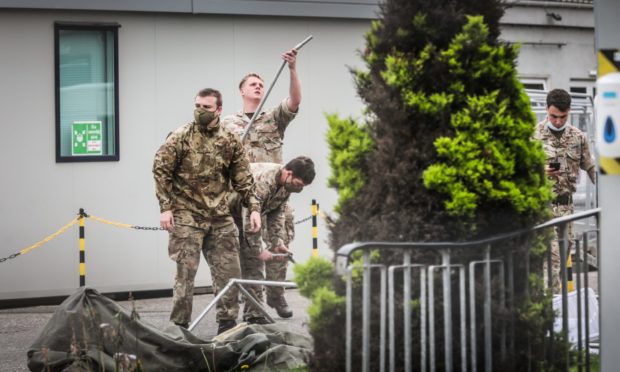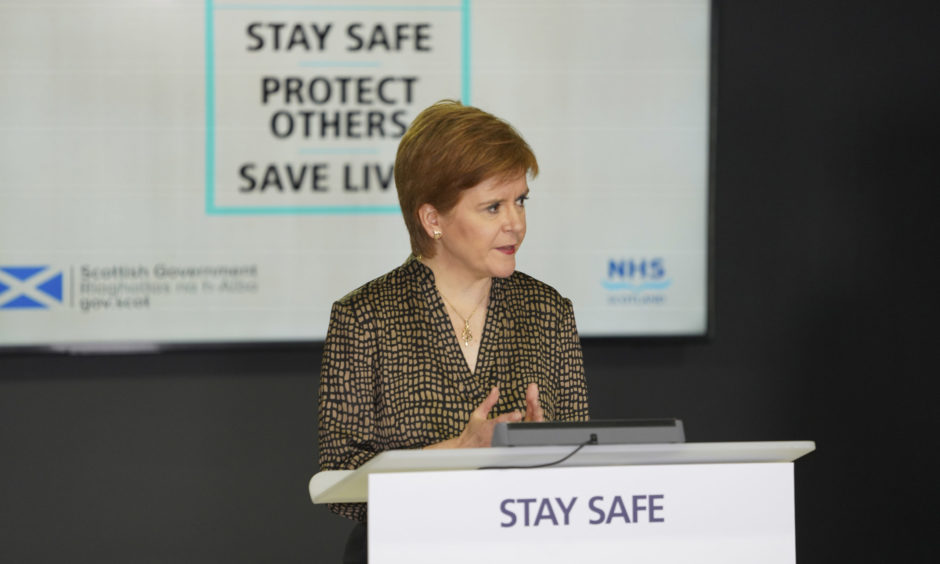Two further factories have been linked to a growing coronavirus outbreak in Tayside, as new figures reveal the region now has the highest risk of local transmission anywhere in Scotland.
The number of cases linked to the 2 Sisters food processing plant in Coupar Angus has risen to 68, and Nicola Sturgeon confirmed 59 employees have now tested positive for the virus, along with nine of their contacts.
Speaking during the Scottish Government’s daily coronavirus briefing on the day Scotland recorded its second-highest number of new cases since May, Ms Sturgeon said 31 of the 71 new positive tests recorded overnight were in Tayside.
A total of 10 of the new cases were in the Grampian health board area, 16 in Greater Glasgow and Clyde, and four in Lanarkshire.
NHS Tayside announced on Thursday that anyone living in a household with a factory worker from the 2 Sisters site, including children, should self-isolate at home and get tested for Covid-19 as soon as possible.
Ms Sturgeon said not all of the 2 Sisters workforce live in Coupar Angus so the situation involves people stretched across Perth and Kinross, Angus and Dundee.
The first minister also confirmed two contacts “have links to other food processing factories in Tayside”, although it is not yet clear which businesses are affected.
“The incident management team is now carrying out risk assessments at both of these sites,”Ms Sturgeon said.
“There’s no evidence that this outbreak has spread to either factory at this stage but, as you can imagine, that is something that is being looked at very closely.”
Ms Sturgeon said lockdown restrictions similar to the ones introduced in Aberdeen two weeks ago had not been imposed because there was currently “minimal evidence of community transmission in Tayside”.
However, she said she could not rule out introducing further measures in the future and the situation would be kept under “very close review”.
A new method of tracking the outbreak has revealed Perth and Kinross has the highest risk of local coronavirus transmission anywhere in Scotland and may require “greater vigilance” from health officials.
The region has surged past other areas dealing with local outbreaks, including Aberdeen, which became the site of Scotland’s first local lockdown following a cluster linked to pubs and bars in the city.
A new Scottish Government report considered whether the current number of Covid-19 infections exceeds what health officials would expect at this stage of the epidemic, based on a new modelling system from Warwick University.
It found six local authority areas – Perth and Kinross, Dundee, North Lanarkshire, Angus, Glasgow and Aberdeen – had exceeded expected levels but figures are beginning to trend towards normal.
The new method is designed to be more useful than the R number – the average number of people infected by each person – because this figure can be volatile when the overall number of deaths is low.
The report states: “While metrics such as the reproductive rate – R number – have been useful in guiding our response to coronavirus so far, the models we use rely on numbers of deaths to track the epidemic.
“These have fallen to low levels, which means we need to find new ways to monitor trends in the epidemic.
“One of the ways we can do this is to calculate whether the number of confirmed infections (based on testing) in each area exceeds the number that was expected, given the number recorded across the country – this is called ‘exceedance’.”
Areas with an exceedance level above six are deemed to be at a higher risk of local transmission and may require “greater vigilance”, according to the report.
In the week leading up to August 17, the only areas above this limit were Perth and Kinross, at 12.7, and Dundee, where a number of workers at the 2 Sisters chicken factory live, at 7.7.
Angus came in at 4.3, Aberdeen at 3.6, and levels in Aberdeenshire are beginning to fall back towards background levels.
The report stated in most cases the figures are “a reflection of a small number of cases”; however, the ongoing nature of the outbreak in Perth and Kinross “may be a cause for concern”.
Speaking about lessons learned from the clusters on Friday, Ms Sturgeon said indoor social gatherings are one of the major drivers of community transmission.
She warned against defying guidelines on the number of people allowed indoors at once, which she said presented “a very significant risk”.
“That tells us that we need to be incredibly cautious about these kinds of gatherings,” she said. “I want to ask everybody again today to remember the advice that is in place and to comply with it.”

